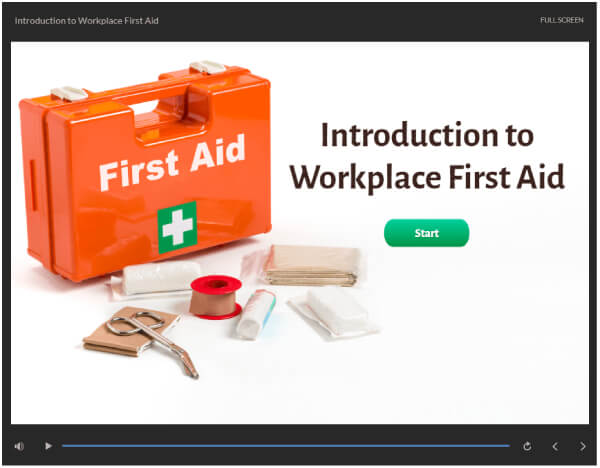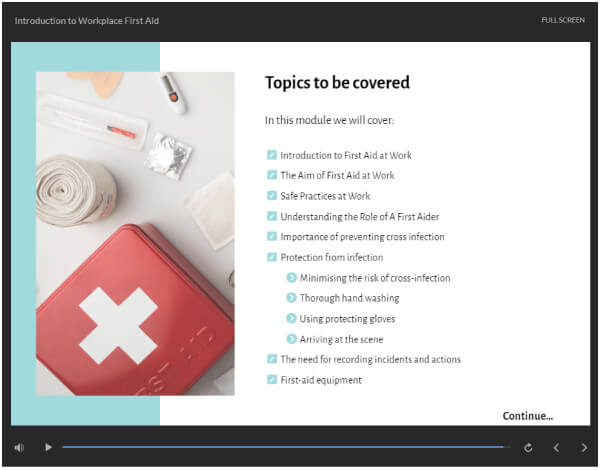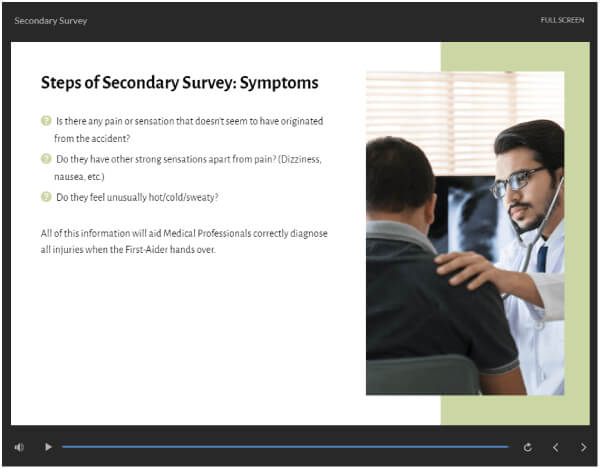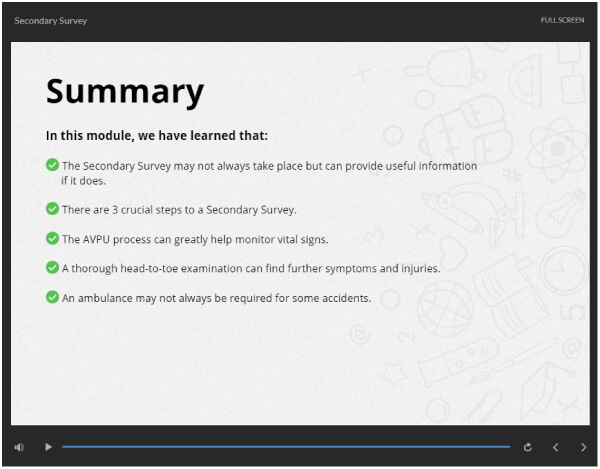GET THIS COURSE AND 1500+ OTHERS FOR ONLY £49 PER YEAR. FIND OUT MORE
Our First Aid at Work Course applies to all employees and includes expert audiovisual tutorials, easy to follow modules and practical advice for low-risk work settings such as offices, restaurants and shops. Key topics include first aid boxes, the recovery position, administering CPR and treating secondary illnesses such as asthma and allergies.
Knowing the basics of first aid is an essential skill to have, whether you’re in a workplace environment or at home. It could be a case of saving someone’s life, so it’s never too late to train. Our First Aid at Work course is designed to introduce you to the legal framework and the basic fundamentals of first aid, from how to act in potentially life-threatening situations, to conducting a head-to-toe check on someone who has sustained an injury.
You will also know when to call for an emergency, learn how to conduct CPR and deal with people suffering from breathing problems, fractures, dislocations and loss of responsiveness. Once the First Aid at Work Training Course is successfully completed, you’ll receive a CPD accredited as proof of your new skills, with the confidence to apply the correct safety measures for your business or workplace.
- Accredited by CPD
- Developed by qualified first aid professionals
- Instant e-certificate and hard copy dispatch by next working day
- Fully online, interactive course with audio voiceover
- Self paced learning and laptop, tablet, smartphone friendly
- 24/7 Learning Assistance
- Discounts on bulk purchases
£26,600 Average Salary, Up to £37,500/yr for this skill according to top UK career sites.
Sneak Peek
Who should take the First Aid at Work Course
This First Aid at Work Course is ideal for all employees or anyone who genuinely wishes to learn more about first aid basics. This will include;
- Office Workers
- Self-Employed workers
- Casual Workers
- Workers in warehouses or factories
- Anyone wishing to start First Aid training
Certification
Once you’ve successfully completed your course, you will immediately be sent a digital certificate. Also, you can have your printed certificate delivered by post (shipping cost £3.99). All of our courses are fully accredited, providing you with up-to-date skills and knowledge and helping you to become more competent and effective in your chosen field. Our certifications have no expiry dates, although we do recommend that you renew them every 12 months.
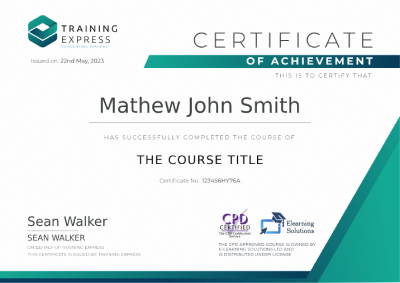
Learning Outcomes
By the end of the course learners will be able to demonstrate that they can;
- Take effective control of an emergency situation in the workplace.
- Tend to minor wounds and prepare major ones for professional treatment.
- Assess the severity of a casualty’s condition and react accordingly.
- Learn how to react to difficult situations involving conditions like seizures and head injuries
- Perform life-preserving procedures such as applying a Recovery Position or giving CPR.
Assessment
At the end of the course, there will be an online assessment, which you will need to pass to complete the course. Answers are marked instantly and automatically, allowing you to know straight away whether you have passed. If you haven’t, there’s no limit on the number of times you can take the final exam. All this is included in the one-time fee you paid for the course itself.
Course Curriculum
Module One introduces the basic principles of First Aid in the workplace and the important responsibilities that a First-Aider must own. It also looks at the requirements of a good First Aid kit and the importance of preventing cross-infection. It also provides a pointer towards initial actions to take when an emergency is encountered.
In Module Two, we explain the legal duties of an employer (and employee) has in regards to providing First Aid equipment and facilities. It also covers the UK legislation that is currently in place, to ensure that the appropriate workers are trained in First Aid skills, along with further health and safety directives. The importance of accident reporting is examined as well.
In Module Three, we look at the way in which First Aid personnel should take charge during incidents and guide events. This naturally leads to the recommended actions to take during an emergency, where they will be influential in conducting safety during accidents involving fire, electricity, and water. This module also emphasises the need for self-safety as a First-Aider.
In Module Four, we look at the importance of a Primary Survey during an incident. It emphasises the importance of recording and understanding all the information that can be taken from the casualty and the incident. The module also instructs the way a Recovery Position can be applied to a patient.
Module Five explains the purpose of a Secondary Survey and why it may not always be necessary. It covers the benefits of a more protracted examination and detailed investigation into an incident. We explain the procedural steps of the survey and just how much it can influence the treatment of the casualty.
Module Six comprehensively describes the most commonly used First Aid techniques. We cover the “Chain of Survival”, and the key recommendations in an emergency. The components of a First Aid kit are also explored, with descriptions of how to apply dressings, bandages, and slings. The life-extending procedures involving CPR and AEDs are highlighted as well.
Module Seven describes the majority of minor injuries that a First-Aider can expect to encounter. It looks at the wide variety of common ailments and wounds that can occur easily, and how best to deal with them. The module also highlights the injuries that can escalate in severity and what to do to ensure the safety of the casualty.
Module Eight starts to cover the Secondary Illnesses that a First-Aider can come across. This module specifically explains the actions required when an adult, child, or baby becomes unconscious. It also goes into detail on how to check for breathing problems and apply resuscitation techniques.
Module Nine continues the theme of treating Secondary illness in a casualty. This module covers the conditions that can cause severe breathing difficulties in an individual, how they should be appropriately treated, and when emergency services should become involved.
Module Ten continues to look at Secondary Injuries that arise from long-time medical conditions or injuries. This covers a range of issues from complications caused by excessive bleeding, to the effects of Epilepsy, and the causes of Heart Attacks. The module also covers the different types of diabetes, and what causes the body to go into shock.
Module Eleven comprehensibly covers the different types of fractures and dislocations. It looks at the different ways bones can break or splinter, along with the appropriate treatment a First-Aider can perform. We also cover the risks behind head injuries and how bone displacement should be handled.
Module Twelve covers and summarises the different types of emergency services that are available in the UK. This final module will affirm the responsibilities of a First-Aider and instructs the learner on how and when to call the appropriate services.
Course Curriculum
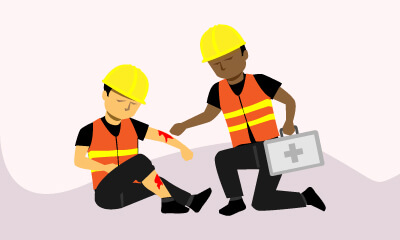 TAKE THIS COURSE
TAKE THIS COURSE
£40.00£20.00 ex VAT- 1 year
- Level 3
- Course Certificate
- 4 hours, 4 minutes Gift this course
Subscribe to this course and 2,000+ top‑rated Training Express courses for your organization.
Try Training Express Business- For teams of 5 or more users
- 2,000+ fresh & in-demand courses
- Learning Engagement tools
- SSO and LMS Integrations
 Food Hygiene
Food Hygiene Health & Safety
Health & Safety Safeguarding
Safeguarding First Aid
First Aid Business Skills
Business Skills Personal Development
Personal Development






